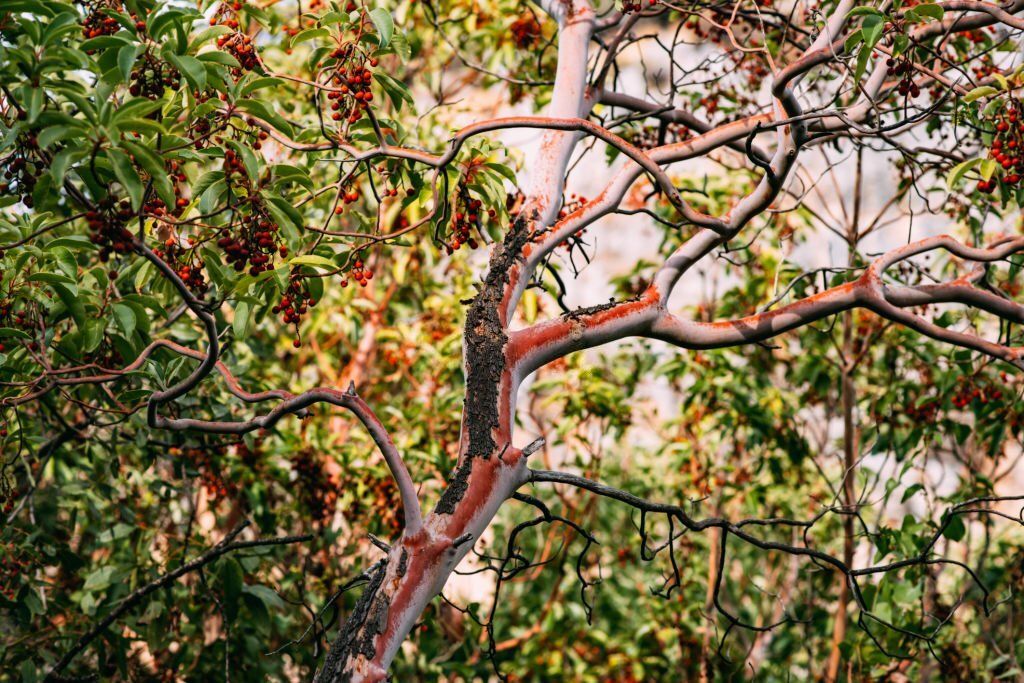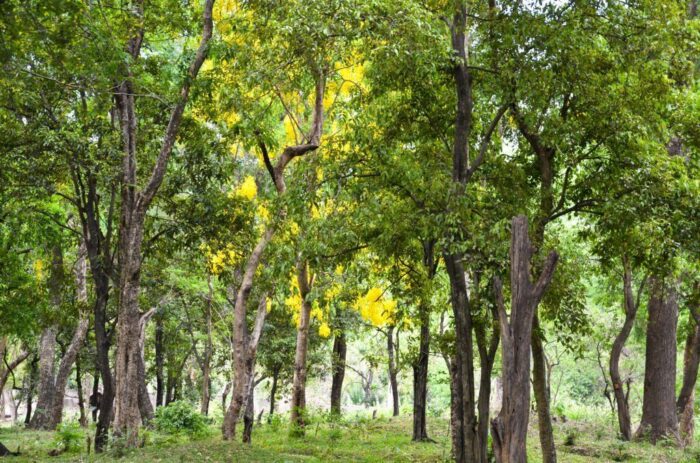M D Seyyon Organic Farm based in Sendamangalam taluk, Tamilnadu offers white sandalwood and red sandalwood tree saplings for farming. The sandalwood and red sandalwood tree saplings offered by M D Seyyon Organic Farm are carefully selected and grown using organic farming methods. The saplings are sourced from healthy and disease-free mother trees, ensuring that they have the best chance of growing into healthy and mature trees.
Red Sandalwood Farming
Red sandalwood, also known as Pterocarpus santalinus, is a highly valued and endangered species of tree that is native to India. Red sandalwood farming involves cultivating the tree for its valuable heartwood, which is used in a variety of applications, including traditional medicine, perfumery, and woodworking.
Red sandalwood farming requires careful planning and management to ensure the long-term health and productivity of the trees. The following are some key considerations for red sandalwood farming:
- Site selection: Red sandalwood trees require well-draining soil and a warm, humid climate. They are typically grown in areas with a rainfall of at least 500 mm per year, and prefer sites with good sunlight exposure.
- Propagation: Red sandalwood trees can be propagated by seed or by grafting. Seed propagation can be challenging, as the seeds require scarification and pre-soaking to germinate. Grafting is a more reliable method of propagation, and involves attaching a scion from a mature tree to a seedling rootstock.
- Planting and Care: Red sandalwood trees should be planted in well-prepared beds or pits, with appropriate spacing to allow for optimal growth. They require regular watering and fertilization, and should be protected from pests and diseases.
- Harvesting: Red sandalwood trees can take up to 15-20 years to mature and produce heartwood. The heartwood is typically harvested by felling the tree and extracting the wood from the trunk and branches. However, sustainable harvesting practices should be followed to ensure the continued productivity of the trees and prevent overexploitation.
Marketing and sales: Red sandalwood is a highly valuable and sought-after commodity, and can be sold for a premium price. However, farmers should ensure that they have a reliable market for their product and follow regulations and requirements for selling and exporting sandalwood.
Red Sandalwood Saplings

Red sandalwood saplings, also known as seedlings or saplings, are young red sandalwood trees that are grown from seeds or cuttings. These saplings are typically around 6-12 months old and are ready for transplantation once they have developed a strong root system and a healthy stem.
Red sandalwood saplings can be grown in nurseries or in the field, depending on the intended use. In nurseries, they are typically grown in pots or trays, where they can be carefully monitored and cared for until they are ready for transplanting. In the field, saplings are planted directly into the ground in rows or grids, where they will continue to grow and develop.
Growing red sandalwood saplings can be a challenging process, as the trees require specific soil and climate conditions to thrive. They prefer well-drained soils and a warm, humid climate, and are sensitive to frost and cold temperatures.
Once established, red sandalwood trees can take several years to reach maturity and produce valuable heartwood, which is highly sought after for its use in traditional medicine and the production of high-end products such as furniture and musical instruments. Proper care and management of red sandalwood saplings is essential to ensure their long-term growth and sustainability, and to support the conservation of this valuable species.
Sandalwood Seeds
Sandalwood seeds are the reproductive structures produced by sandalwood trees, which are members of the Santalum genus. The seeds are typically small, brown, and hard, and can be found inside the fleshy fruit of the sandalwood tree.
Sandalwood seeds are primarily used for propagation, as they can be germinated to grow new sandalwood trees. The seeds are typically harvested from mature sandalwood trees, which can take several years to produce fruits and seeds.
To germinate sandalwood seeds, they must first be removed from the fruit and then cleaned and dried. The seeds can then be planted in a well-draining soil mix and kept warm and moist until they sprout. Depending on the species and growing conditions, sandalwood seeds can take anywhere from several weeks to several months to germinate.
In addition to their use in propagation, sandalwood seeds are also used in traditional medicine and perfumery. The oil extracted from the seeds is believed to have anti-inflammatory, antimicrobial, and anti-cancer properties, and is used in a variety of cosmetic and personal care products.
Overall, sandalwood seeds are a valuable resource that are used for a range of purposes, from propagation to medicine and cosmetics. Proper management and conservation of sandalwood trees and their seeds is essential to ensure the continued availability and sustainability of this valuable species.
Srigandham Trees
Srigandham trees, also known as sandalwood trees, are members of the Santalum genus and are prized for their fragrant wood, which is used in a variety of applications, including traditional medicine, perfumery, and religious ceremonies.
Srigandham trees are native to India, Indonesia, and other parts of Southeast Asia, and can grow up to 12 meters tall with a diameter of 1 meter. They have small, brownish-red flowers that are followed by fleshy fruit containing the tree’s seeds.
The wood of the srigandham tree is highly valued for its fragrance and is used to make a variety of products, including incense, oils, soaps, and cosmetics. In addition, the wood is used in traditional medicine to treat a range of ailments, from digestive issues to skin conditions.
Due to its high value and demand, srigandham trees have been overexploited in some areas, leading to a decline in their populations. As a result, many countries have implemented conservation measures to protect the species, including regulations on harvesting and cultivation.
Cultivation of srigandham trees is also becoming more popular, as it provides a sustainable source of sandalwood while also supporting reforestation and habitat restoration efforts. In some areas, srigandham trees are grown as a cash crop, with farmers selling the wood to processors and manufacturers for use in various products.
Overall, srigandham trees are a valuable and important species that are deeply rooted in the cultural and religious traditions of many parts of the world. Proper management and conservation efforts are essential to ensure the continued availability and sustainability of this valuable resource.
Chandan Seeds
Chandan, also known as sandalwood, is a highly valuable and fragrant tree that is native to India and other parts of Southeast Asia. While the tree produces fruit that contains seeds, chandan is primarily propagated through root cuttings or by grafting.
Propagation by root cuttings involves taking a section of the chandan tree’s root system and planting it in a suitable soil mix. This method is typically used for older trees that have an established root system.
Grafting, on the other hand, involves taking a stem cutting from a chandan tree and attaching it to the rootstock of another plant. This method is often used for younger trees or for trees that are being cultivated for specific purposes, such as for the production of heartwood.
Chandan seeds are also occasionally used for propagation, although they are less commonly used than root cuttings or grafting. The seeds can be germinated by planting them in a well-draining soil mix and keeping them warm and moist until they sprout.
Once germinated, chandan seedlings require careful management and attention to ensure their long-term growth and success. They prefer well-draining soils and a warm, humid climate, and are sensitive to frost and cold temperatures.
Chandan trees are highly prized for their fragrant heartwood, which is used in a variety of applications, including traditional medicine, perfumery, and woodworking. Due to its high value and demand, chandan trees have been overexploited in some areas, leading to a decline in their populations. As a result, many countries have implemented conservation measures to protect the species, including regulations on harvesting and cultivation.
M D Seyyon Organic Farm
No 7, Kullandikadu Road,
Echchamptti Village,
SenthalamgamanTaluk,
Namakkal District- 637 402.
9003166496
seyyonfarms@gmail.com
http://tellmystory.in/indias-super-fast-agro-forest-a-model-for-the-world/
You may also be interested in this Fresh Red Onion Exporter:
